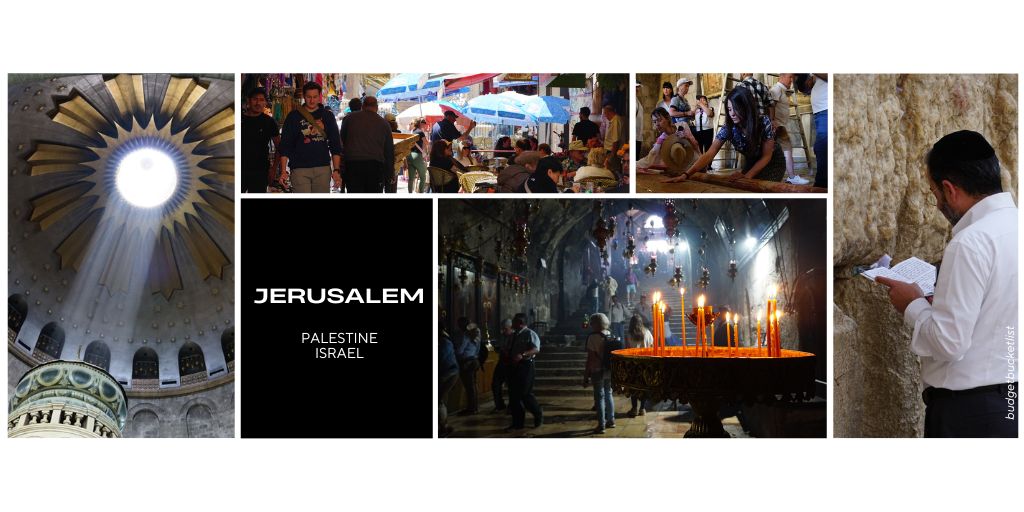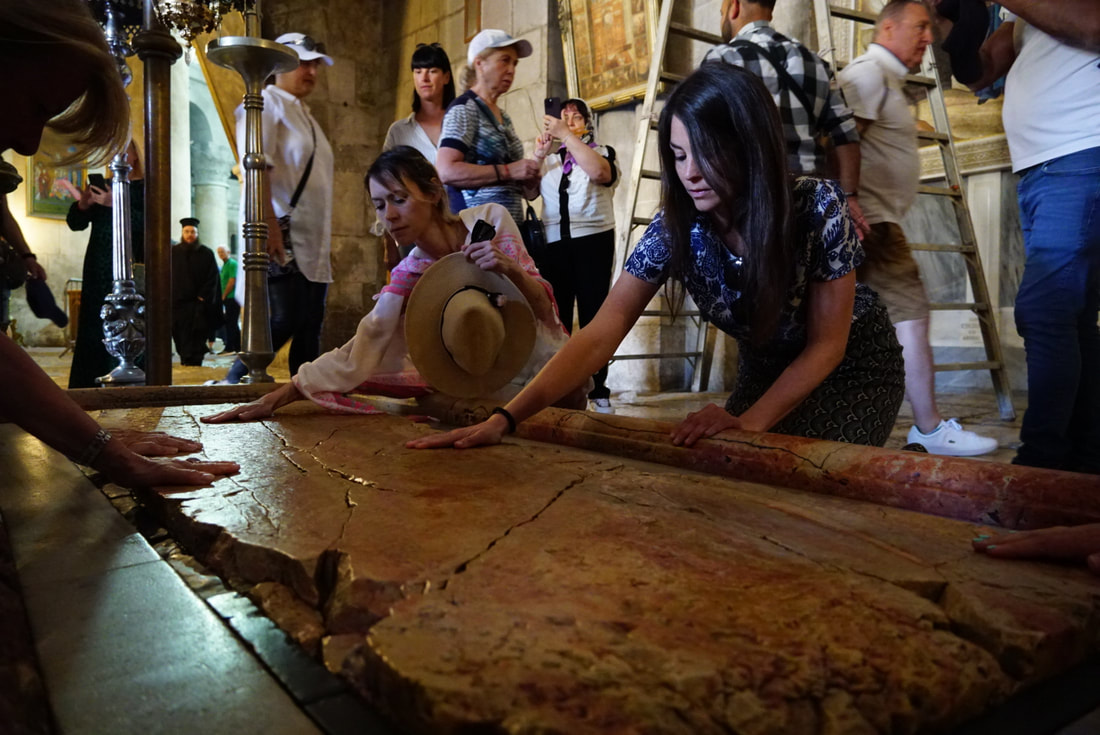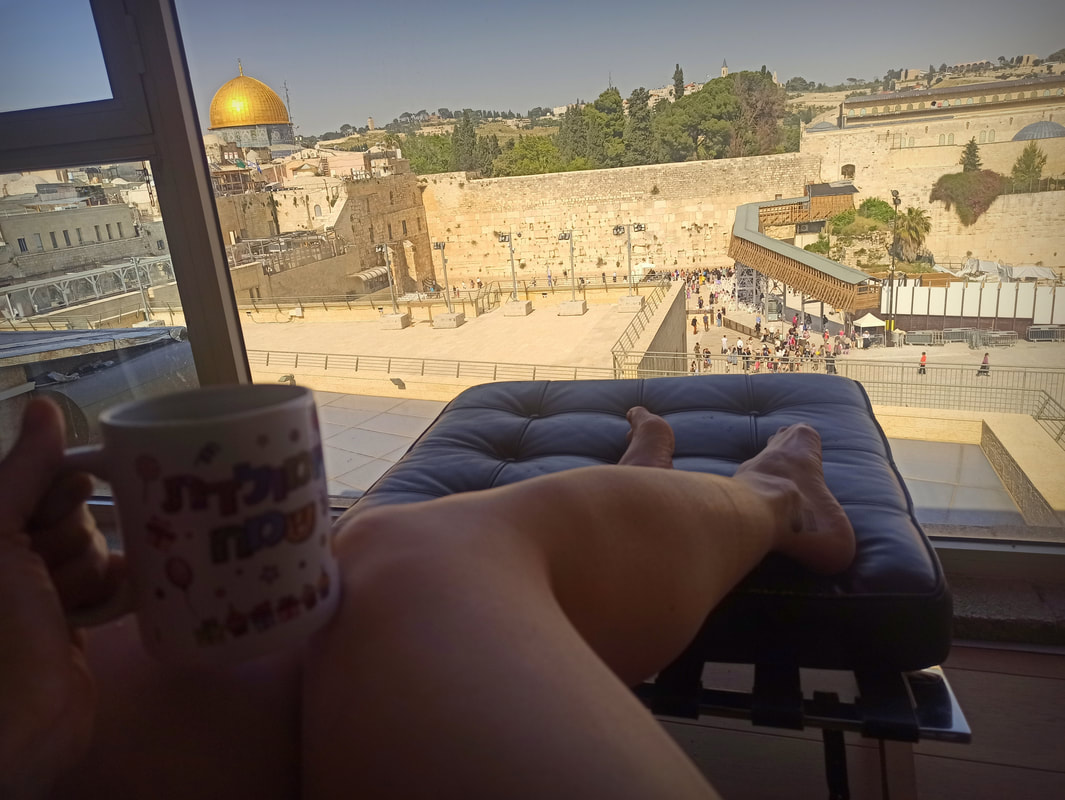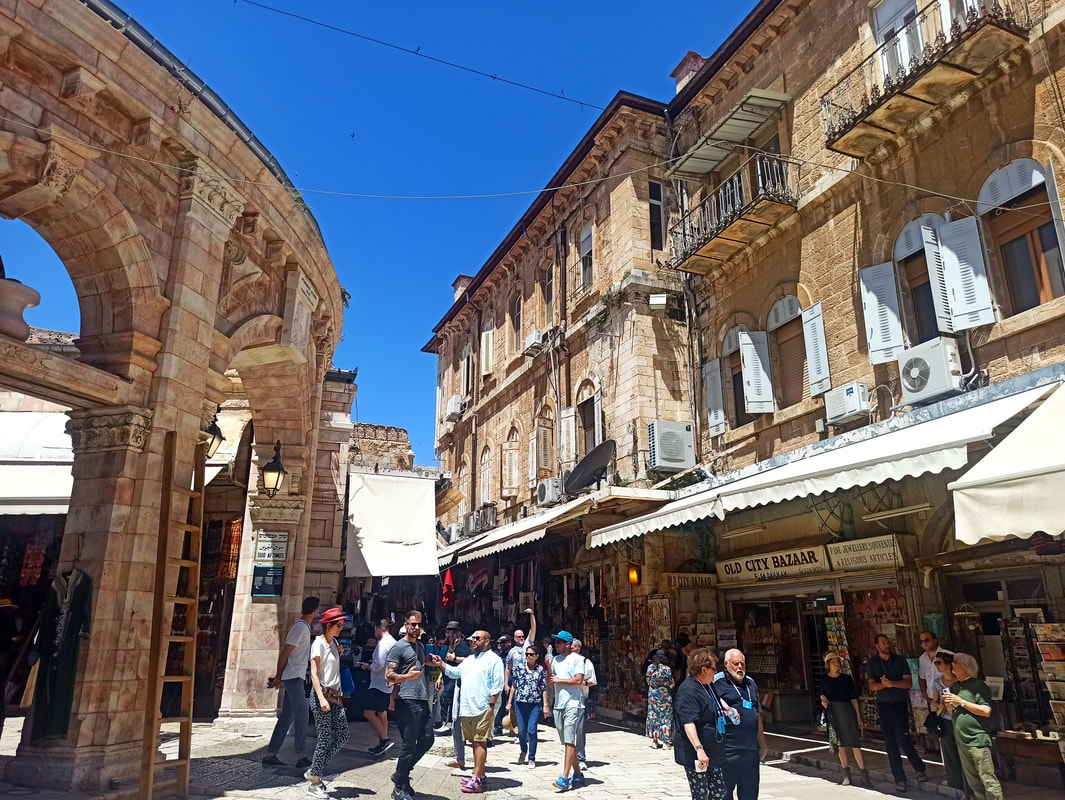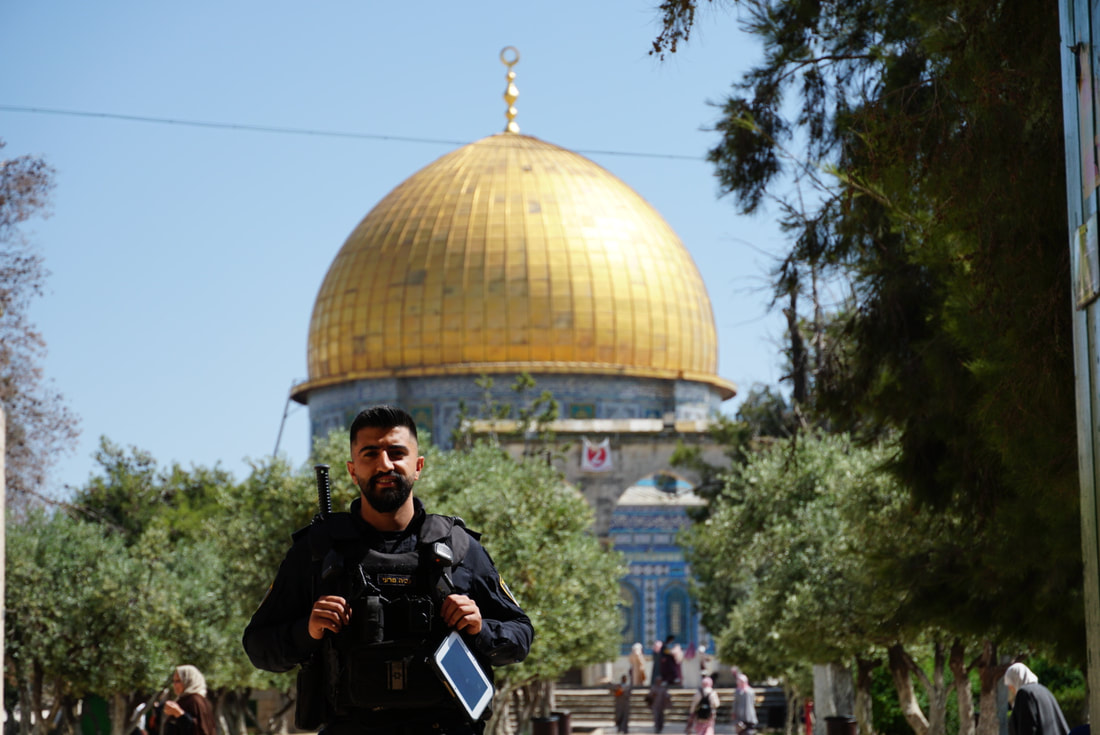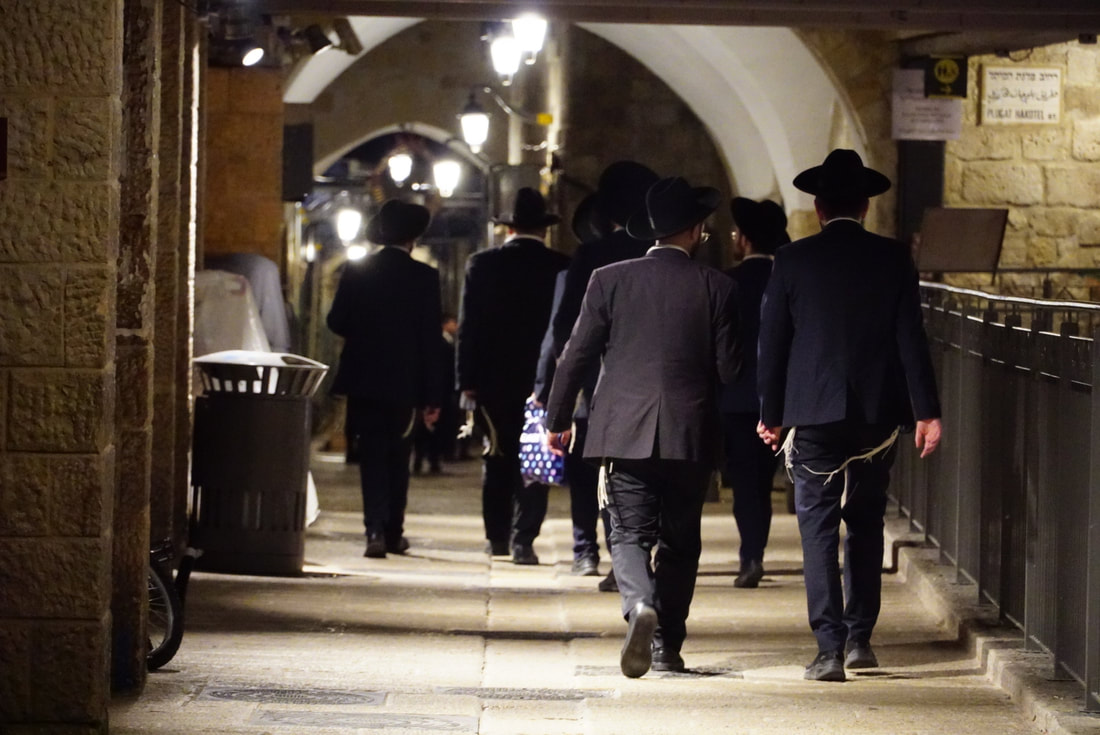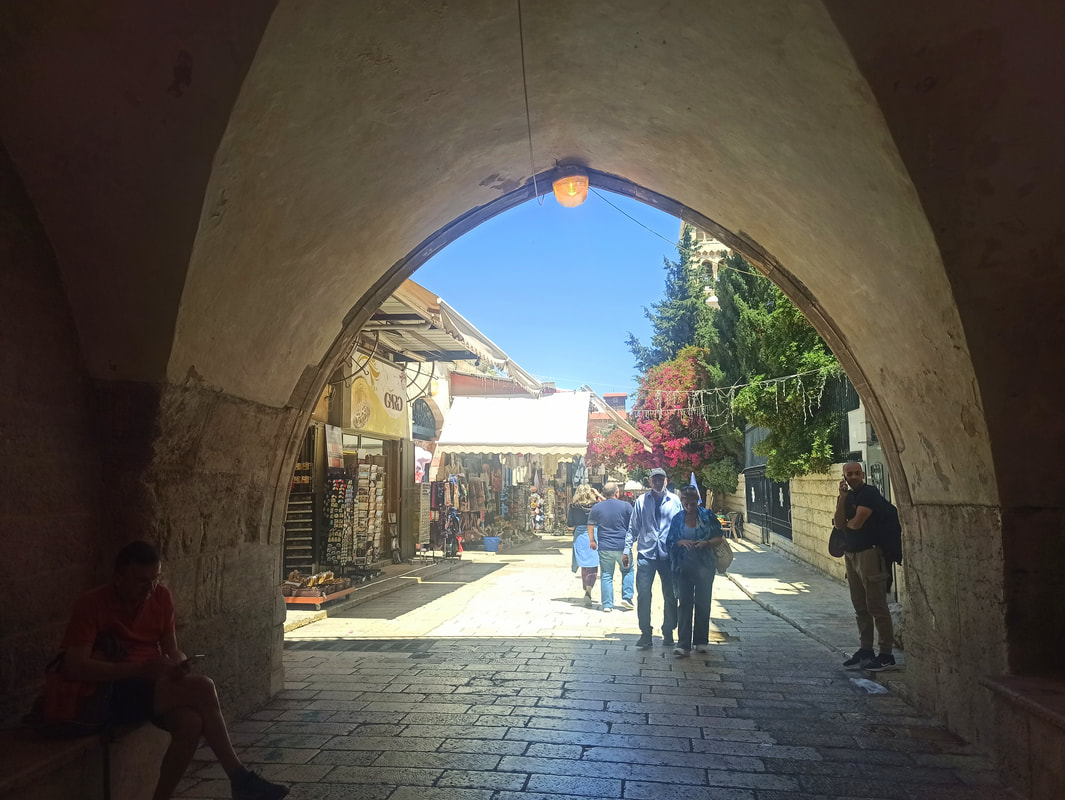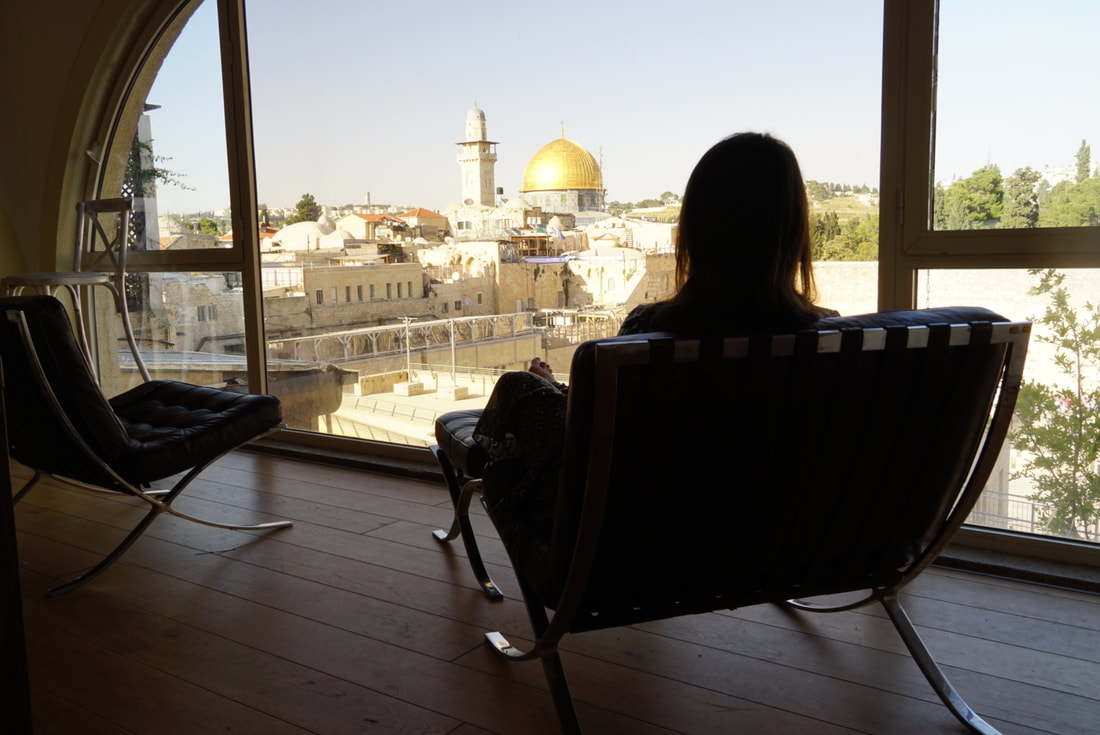Jerusalem
Not in the story-mood? Scroll down for the Quick Budget Fact Overview: an itemized information summary of Jerusalem! ↓
[There is an active war going on between Israel and Palestine. Whereas tourists are not the target group of the attacking parties, safety can’t be guaranteed. Even though the writer of the article also visited during wartime and didn’t experience any life-threatening casualties, it is recommended to verify the current safety situation with locals situated in the areas you intend to visit. This can be done on designated Facebook groups or via the Couchsurfing network. As always, don’t rely on the “information” obtained via mass media or from people who haven’t actually been there themselves. As a weathered traveler, you know the drill.]
[There is an active war going on between Israel and Palestine. Whereas tourists are not the target group of the attacking parties, safety can’t be guaranteed. Even though the writer of the article also visited during wartime and didn’t experience any life-threatening casualties, it is recommended to verify the current safety situation with locals situated in the areas you intend to visit. This can be done on designated Facebook groups or via the Couchsurfing network. As always, don’t rely on the “information” obtained via mass media or from people who haven’t actually been there themselves. As a weathered traveler, you know the drill.]
At this space I am supposed to write an introduction to my article covering Jerusalem. Yet, if there’s one city in the history of humankind that doesn’t need an introduction, it is of course Jerusalem. One of the oldest cities in the world. Holier than holy in the world’s three main religions: Judaism, Christianity and Islam. Proclaimed capital of both the Israelis and the Palestinians, and as such a concrete symbol of a seemingly unresolvable and ongoing conflict. A city with a strong yet variable history, depending on the background of the narrator. A place drenched with deep meaning and multi-layered symbolism.
Jerusalem. I still can’t believe I was actually there.
Jerusalem. I still can’t believe I was actually there.
Photo by Miles Watson Photography
Too busy to read now? No problem, save it for later!
Save on Get Pocket | Save in Browser Bookmarks| Save on Instapaper
Save on Get Pocket | Save in Browser Bookmarks| Save on Instapaper
A Visit to Jerusalem
Jerusalem has been destroyed at least twice, was besieged 23 times, captured and recaptured 44 times and attacked 52 times. As such, it played its fair share of musical chairs when it comes to ownership. But, at the moment, the biggest chunk of the city is under Israeli/Jewish occupation (unrelated to my own political orientation, I am using its official international term: occupation – whether that fact offends anyone or not). And me, the absolute atheist, was going to strongly experience that kosher flavor of the multicultural and multireligious blend. Not in the least because I was being hosted by a rabbi. The orthodoxer-than-orthodox Shimom (incl. the whole attire), who explained to me that Abraham once found himself in the situation of God wanting to speak to him… but he couldn’t, as he was busy hosting Arabs. This taught him that welcoming guests is more important than talking to God, which caused him to be one of the most active Couchsurfing hosts in the city, giving a free shelter to many people simultaneously at all times. Thank God that he is (quite literally in this case), as his house is situated at probably the most iconic spot in town: overlooking the Western Wall! You can pay to access the Western Wall Observation Deck… or you can just stay at Shimom’s, who owns the property right above it (and many others). The absolute Couchsurfing jackpot of Jerusalem!
Jerusalem has been destroyed at least twice, was besieged 23 times, captured and recaptured 44 times and attacked 52 times. As such, it played its fair share of musical chairs when it comes to ownership. But, at the moment, the biggest chunk of the city is under Israeli/Jewish occupation (unrelated to my own political orientation, I am using its official international term: occupation – whether that fact offends anyone or not). And me, the absolute atheist, was going to strongly experience that kosher flavor of the multicultural and multireligious blend. Not in the least because I was being hosted by a rabbi. The orthodoxer-than-orthodox Shimom (incl. the whole attire), who explained to me that Abraham once found himself in the situation of God wanting to speak to him… but he couldn’t, as he was busy hosting Arabs. This taught him that welcoming guests is more important than talking to God, which caused him to be one of the most active Couchsurfing hosts in the city, giving a free shelter to many people simultaneously at all times. Thank God that he is (quite literally in this case), as his house is situated at probably the most iconic spot in town: overlooking the Western Wall! You can pay to access the Western Wall Observation Deck… or you can just stay at Shimom’s, who owns the property right above it (and many others). The absolute Couchsurfing jackpot of Jerusalem!
Visiting the Western Wall (be careful with the term “wailing wall”, as it’s considered derogatory), is obviously the very first thing you do when visiting Jerusalem. The area is of key significance in Judaism, as the presumed site of the Holy of Holies, the most sacred Temple Mount, is lying right behind it. Jews from all over the world come here to pray, often leaving their written prayers inside of the wall. Anyone can visit (yamakas provided upon entry), but take into account that men and women are separated in different sections, the male’s part taking up about three quarters of the entire area.
When looking at the origins of Jerusalem, the earliest evidence we have available today is dating back to fortifications from the Mid- to Late Bronze age (18th BC). The city later (1550-1200 BC) became the capital of an Egyptian city-state, which in the later era had the Canaanites as the main inhabitants… who are believed to be the forefathers of the Israelites. This forms the main claim to the land by Israel. Remains of these times include Hezekiah’s Siloam Tunnel, the Broad Wall defence fortification, the Israelite Tower, and the Silwan Necropolis on the Mount of Olives, containing the Monolith of Silwan and the Tomb of the Royal Steward. Many of these sites can be found in Jerusalem’s Old Town, a UNESCO World Heritage Site (also on the List of World Heritage in Danger), which nowadays has been divided in distinct Jewish, Muslim, Christian and Armenian quarters. The Old City is marked off by city walls, the current version in fact being built in 1538 by Suleiman the Magnificent, under the Ottoman Empire. Since the 1860s, new neighbourhoods began to develop outside of the city walls, in order to house the many pilgrims and offer a solution to the steady overcrowding. Neighbourhoods such as the Russian Compound, the German Colony, the American-Swedish Colony and many others developed over time. These are most definitely also worth a visit for a more thorough understanding of the city’s fibre.
According to the 1947 Partition Plan, Jerusalem is nor Israeli nor Arab, but a neutral “corpus separatum” administered by the UN. The reality we currently live in tells a different story though: Since the annexation of West Jerusalem by Israel in 1948 (Arab-Israeli War) and the later internationally unrecognized and criticized occupation of East Jerusalem and the West Bank (Six-Day War on Temple Mount), many branches of the Israeli government are located in this desired capital… including the Knesset (parliament), the Supreme Court, and the residences if the president and prime minister. The Knesset and Supreme Court can be visited with a guided tour, which are offered free of charge.
Other Jewish-themed sights include Schindler’s Grave, the City of David National Park (archaeological site, not a natural one), King David’s Tomb on Mount Zion, the Synagogues (Hurva, Belz, Italian, Great Synagogues and many others), the Chagall Windows, the Hebrew University and Givat Ram Campus, the Golden Menorah, the Knesset Menorah Monument, Zedekiah’s Cave and Solomon’s Quarries, and Mount Herzl, the national cemetery of Israel. On Mount Herzl one can also find the Yad Vashem, the main Holocaust Museum of Israel and the national memorial of its many unfortunate victims. Visits are free, but must be reserved online in advance. Other options are the Israel Museum and Shrine of the Book, containing the Dead Sea Scrolls (the original holy book), the Friends of Zion Museum, the Hebrew Music Museum, the Nahon Museum of Italian Jewish Art, the Givat Ha-Tachmoshet Ammunition Hill Memorial and Museum, the Herzl Museum, the Menachem Begin Heritage Center Museum, the Old Yishuv Court Museum and the Tower of David Museum (which even has its own evening lightshow). Definitely cultural folks, the Jews.
Other Jewish-themed sights include Schindler’s Grave, the City of David National Park (archaeological site, not a natural one), King David’s Tomb on Mount Zion, the Synagogues (Hurva, Belz, Italian, Great Synagogues and many others), the Chagall Windows, the Hebrew University and Givat Ram Campus, the Golden Menorah, the Knesset Menorah Monument, Zedekiah’s Cave and Solomon’s Quarries, and Mount Herzl, the national cemetery of Israel. On Mount Herzl one can also find the Yad Vashem, the main Holocaust Museum of Israel and the national memorial of its many unfortunate victims. Visits are free, but must be reserved online in advance. Other options are the Israel Museum and Shrine of the Book, containing the Dead Sea Scrolls (the original holy book), the Friends of Zion Museum, the Hebrew Music Museum, the Nahon Museum of Italian Jewish Art, the Givat Ha-Tachmoshet Ammunition Hill Memorial and Museum, the Herzl Museum, the Menachem Begin Heritage Center Museum, the Old Yishuv Court Museum and the Tower of David Museum (which even has its own evening lightshow). Definitely cultural folks, the Jews.
Even though they are currently a minority in between the dense Jewish and Muslim populations, the Christians have quite some business in Jerusalem as well. Jesus’ crucifixion and resurrection might have something to do with it. In fact, the whole city can be considered one big Bible Extravaganza, with the Church of the Holy Sepulchre*, built around the Tomb of Jesus, at its sparkling centre. The church of all churches. Whereas any church in the Holy Land beats all churches worldwide, as they’re built around the tombs of actual saints or on the very spot of biblical events… this church, presumably containing the tomb of Mr. Christ himself as well as the spot of his resurrection, nicknamed “Golgotha”, literally takes the crown. Be prepared for insane lines. If you want to have the full balls-deep experience, you can reach the church by following the Via Dolorosa, the Way of the Cross which Jesus once walked towards his cruel death.
* A church built by Emperor Constantine I when the city was under Roman rule. The Cardo, a traditional Roman (and thus Christian) decorated street, is not located in the Christian, but in the Jewish Quarter of the Old Town.
* A church built by Emperor Constantine I when the city was under Roman rule. The Cardo, a traditional Roman (and thus Christian) decorated street, is not located in the Christian, but in the Jewish Quarter of the Old Town.
Photos by Miles Watson Photography
Other churches that are worth your time, if only for the story: the Church of the Sepulchre of Virgin Mary, containing her tomb, the Church of All Nations and the Notre Dame of Jerusalem (also hosting pilgrims). Of course, there are many-many more… which I listed down below in the Fact Sheet, to not bore you too much. Some underdog-location which I quite enjoyed as well: the Birthplace of the Virgin Mary, hidden in a backstreet and hardly visited by anyone. If any other city in the world had a place of such leverage, the main cathedral would be plunged right on top of it… but hey, you’re in Jerusalem, where they just can’t keep up with the abundancy of holy sites.
For another super-duper-Christian experience, you can actually visit the Cenacle, the presumed location of the notorious Last Supper of Jesus and his mates. This is also believed to be the site where the Holy Spirit alighted upon the apostles on Pentecost. It’s located on Mount Zion, a significant location for both Jews and Christians. This is, by the way, also a popular sunset spot, although I’d recommend the Mount of Olives, which in Christian tradition is the spot where Jesus ascended to Heaven. You can also find the Tombs of the Prophets Haggai, Zechariah and Malachi at this location. At the foot of the hill you can visit the Garden of Gethsemane, where he was arrested just before his crucifixion. While there, you’re facing the Kidron Valley*, separating the Mount of Olives of Mount Zion, which invites for a a walk in those seasons when the local climate doesn’t try to kill you. Other hiking options are presented by the Jerusalem Botanical Gardens (paid) and Mount Scopus National Botanical Garden (free), or the Ein Hemed National Park just outside of the city, nicknamed “Aqua Bella” by the Catholic Crusaders. In this area you can also follow the popular 8km Sataf Nature Trail through the forest and olive grows. Got some more spice in you? Good, the 38km Jerusalem Trail was opened in 2006 to connect the surrounding cultural sites and natural park. Dust of those hiking boots and keep the pace!
* Other valleys and dry riverbeds (called “wadis) surrounding Jerusalem include Hinnom and Tyrepoeon.
Too hot to hike? It often is. Instead, you could spend a day at the museum with your buddies from bible school. The Bible Lands Museum or the Terra Sancta Museum are your go-to Christian options. The Israel Museum, earlier mentioned in the Jewish section, also definitely has some significance to the Christians among us: It contains the Dead Sea Scrolls (found in the Qumran Caves), which are the original writings of all books forming the Old Testament, with the exception of the Book of Esther.
Other churches that are worth your time, if only for the story: the Church of the Sepulchre of Virgin Mary, containing her tomb, the Church of All Nations and the Notre Dame of Jerusalem (also hosting pilgrims). Of course, there are many-many more… which I listed down below in the Fact Sheet, to not bore you too much. Some underdog-location which I quite enjoyed as well: the Birthplace of the Virgin Mary, hidden in a backstreet and hardly visited by anyone. If any other city in the world had a place of such leverage, the main cathedral would be plunged right on top of it… but hey, you’re in Jerusalem, where they just can’t keep up with the abundancy of holy sites.
For another super-duper-Christian experience, you can actually visit the Cenacle, the presumed location of the notorious Last Supper of Jesus and his mates. This is also believed to be the site where the Holy Spirit alighted upon the apostles on Pentecost. It’s located on Mount Zion, a significant location for both Jews and Christians. This is, by the way, also a popular sunset spot, although I’d recommend the Mount of Olives, which in Christian tradition is the spot where Jesus ascended to Heaven. You can also find the Tombs of the Prophets Haggai, Zechariah and Malachi at this location. At the foot of the hill you can visit the Garden of Gethsemane, where he was arrested just before his crucifixion. While there, you’re facing the Kidron Valley*, separating the Mount of Olives of Mount Zion, which invites for a a walk in those seasons when the local climate doesn’t try to kill you. Other hiking options are presented by the Jerusalem Botanical Gardens (paid) and Mount Scopus National Botanical Garden (free), or the Ein Hemed National Park just outside of the city, nicknamed “Aqua Bella” by the Catholic Crusaders. In this area you can also follow the popular 8km Sataf Nature Trail through the forest and olive grows. Got some more spice in you? Good, the 38km Jerusalem Trail was opened in 2006 to connect the surrounding cultural sites and natural park. Dust of those hiking boots and keep the pace!
* Other valleys and dry riverbeds (called “wadis) surrounding Jerusalem include Hinnom and Tyrepoeon.
Too hot to hike? It often is. Instead, you could spend a day at the museum with your buddies from bible school. The Bible Lands Museum or the Terra Sancta Museum are your go-to Christian options. The Israel Museum, earlier mentioned in the Jewish section, also definitely has some significance to the Christians among us: It contains the Dead Sea Scrolls (found in the Qumran Caves), which are the original writings of all books forming the Old Testament, with the exception of the Book of Esther.
Not only the Jews and Christians, but also the Muslims are tied to Jerusalem. In some cases quite literally, as the Jerusalem-born Palestinians cannot leave the city, as that would cause them to lose their right of residence. For our Muslim friends Jerusalem represents the third-holiest city, right after Mecca and Medina (which are both located in Saudi Arabia). It was the spot where the Quran describes Prophet Muhammad’s Night Journey, during which he travelled on a winged horse (buraq) to Al-Aqsa (Mount Zion), where he led the Prophets Ibrahim (Abraham), Musa (Moses), and Isa (Jesus) in prayer, after which he ascended to heaven to speak to Allah (God). Yup, mind the overlap. This, as well as the long-lasting presence of Palestinians on this patch of Earth, far before Israel was even a thing, fuels the claim to the land by Palestine. And voila: Here we’ve got our current struggle.
You can see the Al-Aqsa Mosque peeking out above the Western Wall, next to the true eyecatcher: the Dome of the Rock. That’s, most likely, all you’re going to see… the mosque, as well as the sacred grounds of Temple Mount, in Islamic the Al Haram Al Sharif, are only accessible to Muslims. However, there are certain times (1:30-2:30PM during my time of visit) when Non-Muslims can visit a limited section of the area.
You can see the Al-Aqsa Mosque peeking out above the Western Wall, next to the true eyecatcher: the Dome of the Rock. That’s, most likely, all you’re going to see… the mosque, as well as the sacred grounds of Temple Mount, in Islamic the Al Haram Al Sharif, are only accessible to Muslims. However, there are certain times (1:30-2:30PM during my time of visit) when Non-Muslims can visit a limited section of the area.
Photo by Miles Watson Photography
In many historic periods of Christian rule, all other religions were driven out of Jerusalem. It’s therefore an interesting historical fact that during Islamic rule, this was most definitely not the case. Not only where both the Jews and Christians welcome to stay in the city… when Patriarch Sophronius invited Caliph Omar to pray inside of the Church of the Holy Sepulchre, after surrendering in 637’s Siege of Jerusalem, he kindly declined: He figured he’d better pray outside to prevent the Muslim population from later on wanting to build a mosque on the most holy site of the Christians. Instead, the Mosque of Omar was erected across the street (closed for tourists).
As the area formed, just like a giant chunk of Europe and Asia at the time, part of the Ottoman Empire, the current City Wall, built under the reign of Suleiman the Magnificent, can be considered “Muslim.” The ramparts can actually be walked upon, although that’s a paid activity. The city gates that were existing at Suleiman’s time and form major attractions of the city of Jerusalem include: the Golden Gate, the Damascus Gate, Herod’s Gate, Jaffa Gate, Lion’s Gate, Silwan Gate and Zion Gate. Other “Islamic” activities include a visit to the Islamic Museum on Temple Mount, housing many religious artefacts and rare manuscripts. Or more artsy endeavour can be obtained at the Museum for Islamic Art. The Rockefeller Museum was the first one of its (archaeological) kind in the Middle East, built in 1938 during the British Mandate of Palestine.
In many historic periods of Christian rule, all other religions were driven out of Jerusalem. It’s therefore an interesting historical fact that during Islamic rule, this was most definitely not the case. Not only where both the Jews and Christians welcome to stay in the city… when Patriarch Sophronius invited Caliph Omar to pray inside of the Church of the Holy Sepulchre, after surrendering in 637’s Siege of Jerusalem, he kindly declined: He figured he’d better pray outside to prevent the Muslim population from later on wanting to build a mosque on the most holy site of the Christians. Instead, the Mosque of Omar was erected across the street (closed for tourists).
As the area formed, just like a giant chunk of Europe and Asia at the time, part of the Ottoman Empire, the current City Wall, built under the reign of Suleiman the Magnificent, can be considered “Muslim.” The ramparts can actually be walked upon, although that’s a paid activity. The city gates that were existing at Suleiman’s time and form major attractions of the city of Jerusalem include: the Golden Gate, the Damascus Gate, Herod’s Gate, Jaffa Gate, Lion’s Gate, Silwan Gate and Zion Gate. Other “Islamic” activities include a visit to the Islamic Museum on Temple Mount, housing many religious artefacts and rare manuscripts. Or more artsy endeavour can be obtained at the Museum for Islamic Art. The Rockefeller Museum was the first one of its (archaeological) kind in the Middle East, built in 1938 during the British Mandate of Palestine.
Photos by Miles Watson Photography
If you, for a change, want to focus on the religious blend of Jerusalem and further investigate the necessary dialogue and mutual understanding between the different religions: the Museum on the Seam, right on the division line, is your go-to destination.
Piece of advice from the Budget Bucket List’er: If you’re looking to score an affordable snack or meal, you get way more bang for your buck in the Muslim Quarter, or even better, the Islamic neighbourhoods just outside of the city walls.
Another one: Need to de-stress from this tense religious blend? Depending on your personal preference, the Biratenu Jerusalem Beer Center or Tzuba Winery will take the edge off.
If you, for a change, want to focus on the religious blend of Jerusalem and further investigate the necessary dialogue and mutual understanding between the different religions: the Museum on the Seam, right on the division line, is your go-to destination.
Piece of advice from the Budget Bucket List’er: If you’re looking to score an affordable snack or meal, you get way more bang for your buck in the Muslim Quarter, or even better, the Islamic neighbourhoods just outside of the city walls.
Another one: Need to de-stress from this tense religious blend? Depending on your personal preference, the Biratenu Jerusalem Beer Center or Tzuba Winery will take the edge off.
Photo by Miles Watson Photography
Jerusalem... It originates from a Canaanite name: Urusalim, City of Shalem... referring to a deity, whose name is based on the Hebrew and Arabic word for peace: Shalom, Salam.
City of Peace.
The sad irony is not lost on me.
Jerusalem... It originates from a Canaanite name: Urusalim, City of Shalem... referring to a deity, whose name is based on the Hebrew and Arabic word for peace: Shalom, Salam.
City of Peace.
The sad irony is not lost on me.
→ In the area: Suitable daytrip destinations from Jerusalem include Bethlehem, Hebron, the Dead Sea, Ramallah (all covered in the West Bank article) and even Tel Aviv, destinations located at a doable travel distance.
Jerusalem-Bethlehem: Bus #21 from East Jerusalem Bus Station & Bus #231 from City Centre / Hanevi’im Terminal.
Jerusalem-Hebron: Bus #381 or #383 from Central Bus Station.
Jerusalem-Dead Sea: Bus #486 or #444 and #421 from Central Bus Station.
Jerusalem-Tel Aviv: Direct train connection, half an hour.
You can pay with a charged Rav Kav Card. Moovit and Google Maps both work well .
Jerusalem-Bethlehem: Bus #21 from East Jerusalem Bus Station & Bus #231 from City Centre / Hanevi’im Terminal.
Jerusalem-Hebron: Bus #381 or #383 from Central Bus Station.
Jerusalem-Dead Sea: Bus #486 or #444 and #421 from Central Bus Station.
Jerusalem-Tel Aviv: Direct train connection, half an hour.
You can pay with a charged Rav Kav Card. Moovit and Google Maps both work well .
Quick Budget Fact Overview
Palestine/Israel Facts
Short History Recap (at least, as short as possible for a place like this)
1917: UK seizes Palestine from Ottomans. Balfour Declaration: UK gives support to "national home for the Jewish people" in Palestine. ’20: San Remo Allied Powers conference grants Palestine to Britain as mandate, to prepare for self-rule. Jewish immigration continues. ’22: UK separates Transjordan from Mandate Palestine, forbids Jewish settlement in Transjordan. ’39: UK White Paper limits Jewish migration to Palestine to 10,000 per year. ‘40s: Nazi Holocaust → Jewish mass migration. Jewish armed groups fight for independent Jewish state. ’47: UN recommends partition of Palestine into separate Jewish and Arab states. ’48: Israel declares independence as British mandate ends → admitted to UN. ‘48-’49: 1st Arab-Israeli War, Palestinians driven out of their homes. Armistice agreements give Israel more territory than planned under Partition Plan. Jordan annexes West Bank and eastern Jerusalem. Egypt occupies Gaza. Around 750,000 Palestinian Arabs either flee/expelled. ‘56-’57: Suez Crisis → Israel & UK/France plan to invade Egypt to re-open canal to Israeli shipping. UN buffer force set up in Sinai and Gaza, Israeli shipping allowed. ’57: Israel & France begin to build a large nuclear reactor in Negev Desert → basis for unconfirmed nuclear weapons programme. ’62: Concerns about the Middle Eastern balance of power prompts US to sell Israel missiles + France provides arms supplies to Israel in ’66. ’64: National Water Carrier brings water from Jordan River to Negev → tensions with Arabs. ’67: Six Day War → Israel launches attack on Egypt → Jordan and Syria join war. War leaves Israel in control of east Jerusalem, West Bank, Gaza, Golan Heights and Sinai. Jewish settlements are set up in all of these areas. ’72: Black September → Palestinian gunmen take the Israeli team hostage at the Munich Olympics. 2 athletes murdered, 9 killed during failed rescue attempt. ’73: Egypt & Syria launch attack against Israeli forces in occupied Sinai & Golan Heights (Yom Kippur / October War) → Israel prevails. ’74: Gush Emunim movement formed to promote Jewish religious settlements on West Bank. ’76: Land Day → 6 Arabs killed by mass protests against government attempts to expropriate land in the Galilee area of northern Israel. ’81: Israeli Force raid destroys nuclear reactor at Osirak in Iraq. ’82: Israel invades Lebanon to expel Palestine Liberation Organisation (PLO) leadership after assassination attempt by small Palestinian militant group on Israeli ambassador. ’82: Massacre of Palestinians in the Sabra and Shatila camps in Beirut. ’85: Introducing Israeli Shekel to beat hyperinflation. ’85: Israel withdraws from most of Lebanon but continues to occupy narrow "security zone" along border. ’87: First Intifada uprising begins in Occupied Territories. Muslim Brotherhood in Gaza forms Hamas movement → violence against Israel. ’90: Soviet Union allows Jews to emigrate, leading to about a million ex-Soviet citizens moving to Israel. ’91: Gulf War → Iraq fires 39 missiles at Israel in failed attempt to regionalise conflict. Israel refrains from responding at US request. ’93: Oslo Declaration for Palestinian self-government. ’94: Israel withdraws from most of Gaza and Jericho. ’94: Jordan & Israel sign peace treaty. Yitzhak Rabin, Yasser Arafat and Israeli Foreign Minister Shimon Peres jointly awarded Nobel Peace Prize. ’95: Jewish extremist shoots Yitzhak Rabin dead in Tel Aviv. 2000: Israel withdraws from southern Lebanon. ’02: Israeli army launches Operation Defensive Shield on West Bank after Palestinian suicide bombings. Israel begins building barrier in and around West Bank = interpreted as defence by Israelis, but as a way to grab more land by Palestinians. US, EU, Russia & UN propose road map to resolve Israeli-Palestinian conflict, proposing independent Palestinian state. Israel & Palestinian National Authority both accept plan, which requires freeze on West Bank Jewish settlements and an end to attacks on Israelis. ’04: International Court of Justice issues advisory opinion that West Bank barrier is illegal. ’05: Israel withdraws all Jewish settlers and military personnel from Gaza, while retaining control over airspace, coastal waters & border crossings. Hamas wins Palestinian parliamentary elections → rocket attacks on Israel from Gaza escalate + frequent Israeli raids. ’06: Second Lebanon War. ’08: Israel Gaza invasion. ’09: Discovery of major offshore natural gas deposits. ’11: Hamas release Israeli soldier Gilad Shalit in exchange for 1,027 prisoners. ’14: Military campaign Gaza. ’15: Wave of shootings, stabbings and car-rammings by Palestinians or Israeli Arabs. ’16: US military aid package. ’17: Parliament passes a law which retroactively legalises dozens of Jewish settlements built on private Palestinian land in the West Bank. UNESCO votes to declare the Old City of Hebron a Palestinian World Heritage site. ’17: US President Trump recognises Jerusalem as the capital of Israel, upsetting the Arab world and some Western allies. Then he recognised Israeli sovereignty over the Golan Heights, which Israel seized from Syria in the 1967 war and later annexed. The international community does not recognise Israeli sovereignty. ’18: UN and Egypt attempt to broker a long-term ceasefire between Israel and Hamas. ’19: US no longer considers Israeli settlements on the West Bank to be illegal. ’20: United Arab Emirates 1st Gulf state to establish diplomatic relations with Israel. ’21: Forced evictions of Palestinians in east Jerusalem. ’23: War fires up again, Israel initiates genocide of Palestinians.
Palestine/Israel Facts
- Capital: Jerusalem (Ramallah is Palestine’s de facto capital during the occupation)
- Language: Hebrew / Arabic
- Population: ± 9.3 mln Israel / 3 mln West Bank / 590,500 Gaza (Nazareth: 77,445) – the population numbers especially in the Palestinian areas are very flexible, due to the ongoing genocide)
- Sq km: ± 22,145 Israel / 5,860 West Bank / 365 Gaza (Nazareth: ± 16.5)
- Currency: Shekel (₪ - NIS)
- Electricity Outlet: C + H / 230 V / 50 Hz. Check here.
- Country Code Phone: +972
- Emergency Phone: 112 (general), 100 (police), 101 (ambulance), 102 (fire)
- Visa: Find more info about visas for Israel on this page. Unless you’re Israeli, you can enter the West Bank without any issues. More info for an easy visa application here.
- Vaccinations: None
- Climate: Hot Summer Mediterranean Climate (Csa)
- High season: June – September (also really hot)
Short History Recap (at least, as short as possible for a place like this)
1917: UK seizes Palestine from Ottomans. Balfour Declaration: UK gives support to "national home for the Jewish people" in Palestine. ’20: San Remo Allied Powers conference grants Palestine to Britain as mandate, to prepare for self-rule. Jewish immigration continues. ’22: UK separates Transjordan from Mandate Palestine, forbids Jewish settlement in Transjordan. ’39: UK White Paper limits Jewish migration to Palestine to 10,000 per year. ‘40s: Nazi Holocaust → Jewish mass migration. Jewish armed groups fight for independent Jewish state. ’47: UN recommends partition of Palestine into separate Jewish and Arab states. ’48: Israel declares independence as British mandate ends → admitted to UN. ‘48-’49: 1st Arab-Israeli War, Palestinians driven out of their homes. Armistice agreements give Israel more territory than planned under Partition Plan. Jordan annexes West Bank and eastern Jerusalem. Egypt occupies Gaza. Around 750,000 Palestinian Arabs either flee/expelled. ‘56-’57: Suez Crisis → Israel & UK/France plan to invade Egypt to re-open canal to Israeli shipping. UN buffer force set up in Sinai and Gaza, Israeli shipping allowed. ’57: Israel & France begin to build a large nuclear reactor in Negev Desert → basis for unconfirmed nuclear weapons programme. ’62: Concerns about the Middle Eastern balance of power prompts US to sell Israel missiles + France provides arms supplies to Israel in ’66. ’64: National Water Carrier brings water from Jordan River to Negev → tensions with Arabs. ’67: Six Day War → Israel launches attack on Egypt → Jordan and Syria join war. War leaves Israel in control of east Jerusalem, West Bank, Gaza, Golan Heights and Sinai. Jewish settlements are set up in all of these areas. ’72: Black September → Palestinian gunmen take the Israeli team hostage at the Munich Olympics. 2 athletes murdered, 9 killed during failed rescue attempt. ’73: Egypt & Syria launch attack against Israeli forces in occupied Sinai & Golan Heights (Yom Kippur / October War) → Israel prevails. ’74: Gush Emunim movement formed to promote Jewish religious settlements on West Bank. ’76: Land Day → 6 Arabs killed by mass protests against government attempts to expropriate land in the Galilee area of northern Israel. ’81: Israeli Force raid destroys nuclear reactor at Osirak in Iraq. ’82: Israel invades Lebanon to expel Palestine Liberation Organisation (PLO) leadership after assassination attempt by small Palestinian militant group on Israeli ambassador. ’82: Massacre of Palestinians in the Sabra and Shatila camps in Beirut. ’85: Introducing Israeli Shekel to beat hyperinflation. ’85: Israel withdraws from most of Lebanon but continues to occupy narrow "security zone" along border. ’87: First Intifada uprising begins in Occupied Territories. Muslim Brotherhood in Gaza forms Hamas movement → violence against Israel. ’90: Soviet Union allows Jews to emigrate, leading to about a million ex-Soviet citizens moving to Israel. ’91: Gulf War → Iraq fires 39 missiles at Israel in failed attempt to regionalise conflict. Israel refrains from responding at US request. ’93: Oslo Declaration for Palestinian self-government. ’94: Israel withdraws from most of Gaza and Jericho. ’94: Jordan & Israel sign peace treaty. Yitzhak Rabin, Yasser Arafat and Israeli Foreign Minister Shimon Peres jointly awarded Nobel Peace Prize. ’95: Jewish extremist shoots Yitzhak Rabin dead in Tel Aviv. 2000: Israel withdraws from southern Lebanon. ’02: Israeli army launches Operation Defensive Shield on West Bank after Palestinian suicide bombings. Israel begins building barrier in and around West Bank = interpreted as defence by Israelis, but as a way to grab more land by Palestinians. US, EU, Russia & UN propose road map to resolve Israeli-Palestinian conflict, proposing independent Palestinian state. Israel & Palestinian National Authority both accept plan, which requires freeze on West Bank Jewish settlements and an end to attacks on Israelis. ’04: International Court of Justice issues advisory opinion that West Bank barrier is illegal. ’05: Israel withdraws all Jewish settlers and military personnel from Gaza, while retaining control over airspace, coastal waters & border crossings. Hamas wins Palestinian parliamentary elections → rocket attacks on Israel from Gaza escalate + frequent Israeli raids. ’06: Second Lebanon War. ’08: Israel Gaza invasion. ’09: Discovery of major offshore natural gas deposits. ’11: Hamas release Israeli soldier Gilad Shalit in exchange for 1,027 prisoners. ’14: Military campaign Gaza. ’15: Wave of shootings, stabbings and car-rammings by Palestinians or Israeli Arabs. ’16: US military aid package. ’17: Parliament passes a law which retroactively legalises dozens of Jewish settlements built on private Palestinian land in the West Bank. UNESCO votes to declare the Old City of Hebron a Palestinian World Heritage site. ’17: US President Trump recognises Jerusalem as the capital of Israel, upsetting the Arab world and some Western allies. Then he recognised Israeli sovereignty over the Golan Heights, which Israel seized from Syria in the 1967 war and later annexed. The international community does not recognise Israeli sovereignty. ’18: UN and Egypt attempt to broker a long-term ceasefire between Israel and Hamas. ’19: US no longer considers Israeli settlements on the West Bank to be illegal. ’20: United Arab Emirates 1st Gulf state to establish diplomatic relations with Israel. ’21: Forced evictions of Palestinians in east Jerusalem. ’23: War fires up again, Israel initiates genocide of Palestinians.
Photo by Miles Watson Photography
FREE Sights / Activities
PAID Sights / Activities
Full list here.
Evening Entertainment Tel Aviv
Local Festivals
FREE Sights / Activities
- Sights: Old Town, Jewish Quarter, Muslim Quarter, Christian Quarter, Armenian Quarter, Me’a She’arim neighbourhood (Orthodox Jewish), German Colony, Russian Compound, American-Swedish Colony, Western Wall, Western Wall Tunnels, Temple Mount / Al Haram Al Sharif, Dome of the Rock / Al-Aqsa Mosque (not accessible for non-Muslims), Church of Holy Sepulchre (Tomb of Jesus), Golgotha, Via Dolorosa / Way of the Chross, Tomb of the Virgin Mary, Birthplace of Virgin Mary, Church of All Nations, Church of St. Anne, Church of St. Peter, Church of the Pater Noster, St. James Cathedral Church, St. George’s Monastery, St. Mark’s Syriac Church, Church of Condemnation and Flagellation, Dormition Abbey, Dominus Flevit Church, Church of St. Mary Magdalena, Church of St. Alexander Nevsky, Ecce Homo Jerusalem Historic Pilgrim House, Church & Mosque of the Ascension, Mosque of Omar, Gornenskiy Monastery, Monastery of the Cross, Hurva Synagogue, Jerusalem Great Synagogue, Belz Great Synagogue, Italian Synagogue, Chagall Windows, Cardo, Jaffa Gate, Damascus Gate, Golden Gate, Zion Gate, Dung Gate, St. Stephen’s Gate, Herod’s Gate, Lion’s Gate, Silwan Gate, Mount Herzl National Cemetery, Knesset Parliament, Supreme Court, Hebrew University / Givat Ram Campus, Schindler’s Grave, King David’s Tomb, Golden Menorah, Knesset Menorah Monument, Tombs of the Prophets Hezekiah’s Siloam Tunnel, Broad Wall, Israelite Tower, Silwan Necropolis, Monolith of Silwan, Tomb of the Royal Steward, Haggai / Zechariah / Malachi, Tomb of Lazarus, The Cenacle (Last Supper).
- Museums: Yad Vashem (Holocaust Remembrance Center – reservation necessary).
- Hikes / Nature: Sataf Nature Trail, Kidron Valley, Garden of Gethsemane, Mount of Olives, Mount Zion, Independence Park, Gan Sacher Park, Mount Scopus National Botanical Garden.
- Daytrips: Bethlehem, Dead Sea, potentially Tel Aviv.
PAID Sights / Activities
- Sights: Zedekiah’s Cave / Solomon’s Quarries.
- Museums: Israel Museum / Shrine of the Book (incl. Dead Sea Scrolls), Tower of David Museum & Lightshow, The Friends of Zion Museum, Bible Lands Museum, Terra Sancta Museum, Hebrew Music Museum, Nahon Museum of Italian Jewish Art, Givat Ha-Tachmoshet Ammunition Hill Memorial and Museum, Herzl Museum, Menachem Begin Heritage Center Museum, Pontifical Institute Notre Dame of Jerusalem Center, L.A. Mayer Museum for Islamic Art, Rockefeller Archeaological Center, Ophel Archaeological Garden, Wohl Archaeological Museum, Bloomfield Science Museum, Museum of the Underground Prisoners, Museum of the Seam, Old Yishuv Court Museum.
- Nature: Soreq Cave, Jerusalem Botanical Gardens.
- Other: City of David National Park, Herodyon National Park, Nebi Samuel National Park, Ein Hemed National Park, Ramparts Walk, Western Wall Observation Deck, Biratenu Jerusalem Beer Center, Tzuba Winery.
Full list here.
Evening Entertainment Tel Aviv
- Nightlife Areas: Modern City Center → Jaffa Street & Zion Square towards Machane Yehuda Market.
- Theatres: Jerusalem Theatre, Palestinian National Theatre, Train Theatre, Khan Theatre, Theatre in the Rough.
Local Festivals
- Winter Noize Festival – Feb.
- Jerusalem Day (Yom Yerushalayim) – May.
- Jerusalem Festival of Lights – Jun-Jul.
- Moonlight Cinema Festival – Jun-Aug.
- Jerusalem Film Festival – Jul.
- Jerusalem Woodstock Revival – Jul.
- Jerusalem Wine Festival – Jul.
- The Israel Festival – Aug.
- Jerusalem Beer Festival & Cocktail Fest – Aug.
- Jerusalem Arts and Crafts Fair – Aug.
- Season of Culture Festival – Aug-Sep.
- Jerusalem Sacred Music Festival – Sep.
- Abu Gosh Music Festival – Oct.
- Jerusalem Indie City Festival – Oct.
- Formula Jerusalem – Oct.
- Jerusalem Knights Festival – Nov.
- International Oud Festival – Nov.
- Made in the City Festival – Nov.
- Jazz Globus Festival – Nov-Dec.
- Hamshusalayim Festival – Dec.
- Jerusalem Jewish Film Festival – Dec.
Budget Bites
Sleep Cheap
- Supermarkets: Coop & mainly one-of-a-kind supermarket or non-chain shops.
- Markets: Mahane Yehuda Market, Emek Refaim Market.
- Local Dishes: Falafel, Hummus, Ful (bean hummus), Shoarma, Shakshouka (eggs with tomato sauce dish), Kreplach (dumplings), Orez Shu’it (bean dish), Bourekas (stuffed pastry), Jachnun (pastry), Merguez (spicy sausage), Denesse (fish with yoghurt), Kugel (casserole), Sabich (stuffed pita sandwich), Matzah Brei (egg dwww.happycow.net/asia/israel/ish), Cholent (stew), Skewered Goose Liver, Kubba Seleq (beet stew), Freekeh (smoky green wheat), Ziva (type of burek), Matfoul (giant couscous), Musakhan (roasted chicken on flatbread), Maraq Adashim (lentil soup), Maraq Shuit (white bean soup), Malabi (dessert), Labneh (salty yoghurt), Challah (braided egg bread), Taboon (flatbread), Matzo (crunchy flatbread), Rugelach (pastry), Za’atar & Sumac (spice blend).
- The Veg Situation: Going veg is not so complicated in Palestine/Israel, as lots of Jewish and Arabic food is already vegetarian. A veg restaurant guide can be found here. Local vegetarian dishes: Falafel, Hummus, Ful, Shakshouka, Orez Shu’it, Kubba Seleq, Freekeh, Ziva, Matfoul, Maraq Adashim, Maraq Shuit, Labneh, Challah, Taboon, Matzo, Rugelach, Za’atar, Sumac, Brik (deep-fried pastry), Burgul (wheat), Jakhnun (tomato pastry), Kishka (stuffed derma), Ktzitzot Khubeza (patty made of bulgur/bread crumbs, eggs and onion), Kubba Bamia (semolina or okra dumplings), Macaroni Hamin, Malawach (tomato bread), Ptitim (toasted pasta).
- National Drink: Arak (anise spirit), Goldstar Beer, Kosher Wine, Sachlav (hot milk with coconut), Limonana (icy mint lemonade).
Sleep Cheap
- Hostels / Hotels: Palestine/Israel is definitely not cheap, which also goes for the accommodations. The West Bank area is slightly cheaper, but still, definitely not a budget option. To keep inside a limited budget, you’ll have to focus on hostels… and even those can be pricy. Without being paid to say so, I love Booking.com: They have the biggest selection, are transparent about the final price and have an efficient search engine tailored to your specific needs (cheapest first!). If you use it often enough, Genius-discounts are applied. Agoda is often not transparent about prices, adding a lot of additional costs in the last booking-step. Opodo is another decent option. Air BnB is not what it used to be, price-wise, and seem to focus on the more upscale boutique stays nowadays.
- Couchsurfing: allows you to stay with locals. Nowadays it has a moderate sign-up cost (unless you put a third-world country as homebase), but paying extra for verification is unnecessary: Positive reviews are way more important. Once active, there are no costs for staying at someone’s house. In order to get accepted, make sure to write an elaborate review explaining why you applied to this specific profile and think you and your host are a good match (copy-pastes tend to be ignored). The Couchsurfing community in Israel/Palestine is rather big and finding a host shouldn’t be too complicated. Writer’s pick: I Couchsurfed in Jerusalem, and stayed at the best spot imaginable, overlooking the Western Wall.
- Housesitting: is an amazing exchange allowing you to stay short- or long-term in somebody’s house, while looking after their house and pets. There are many different websites, most of them paid… but once you landed a sit, the subscription fee pays itself back quickly. The main housesitting site is Trusted Housesitters.
- Wild Camping: is legal in Palestine/Israel, with the exception of private farmland. Take into account that the heat can be overwhelming, even in spring or autumn.
Photo by Miles Watson Photography
Mama Said
Transport
Next?
Mama Said
- Safety: To claim that Palestine/Israel is a safe place would be a lie, considering there’s an unsolvable war going on. However, the ongoing violence and attacks happen between the Israelis and Palestinians and are by no means specifically pointed at tourists. In fact, you’ll notice that both the Israelis and especially Palestinians tend to treat foreign visitors with great respect. However, it is recommended to practice vigilance. Try to avoid uproars or protests.
- Shabbat: The Israeli part of the country just shuts down during Shabbat, which happens from 3PM on a Friday to around 9PM on a Saturday night. Shops will be closed and there is absolutely no public transport, not even to the airports. I learned this the hard way (I could only catch my flight by hitchhiking to the airport with a Palestinian car). In the West Bank area, there is no such inconvenience.
- Tap Water: is safe to drink, except at the Dead Sea.
- The best credit/debit card for traveling is Wise, as they use the live conversion rates with minimal exchange fees. Wise also has the lowest fees for sending money to foreign accounts. Revolut is comparable, but they have higher exchange fees in the weekend and less wallet-options. Also, you can only wire money to Revolut in the currency you opened the account with, whereas Wise has IBAN’s from a wide variety of currencies, so you don’t have to pay a double exchange fee.
- Simcard: Buying a local simcard is by all means cheaper than using your international roaming option. The main providers are Golan, Partner, Pelephone, 019, Hot Mobile, 012 Mobile and Rami Levy. Golan and 012 Mobile have the cheapest deals. Some sims only cover Israel, some cover the entire Middle East. Depending on your further travel plans, you can choose your prepaid simcard accordingly. It is recommended to buy the simcard at phone shops in the main cities, as airports by default have rip-off “tourist plans.” A passport is needed for sim registration. An Israeli simcard will also work in the West Bank.
Transport
- Walking: It is convenient to explore the downtown areas of Nazareth on foot. The city is only 16.5 square kilometres.
- City Buses / Tram / Metro: Jerusalem offers buses to get around. However, due to the heavy traffic situation, this can be a rather time-consuming way to get around. Therefore, the light rail network of Jerusalem is more efficient. Payment throughout entire Israel is possible with the Rav Kav Card, which can be bought and charged at the airport, train stations, light rail stations, kiosks and even at designated ATMs. You can also add money to your balance via the Rav Kav app. Children under 5 ride free of charge. Every ride is valid for 90 minutes, including transfers. The fare depends on distance, area and transportation type. The unofficial minibus services cannot be paid with the Rav Kav Card. Both Google Maps and Moovit work here, but the latter is more accurate. Important: All public transport stops at 3PM on a Friday and resumes Saturday night, due to Shabbat. There will be nothing available in the Israeli areas, also not to the airport. In the West Bank and Palestinian areas, this isn’t relevant.
- Taxi / Uber: Israel’s main taxi app is Gett. In the Palestinian area you can use Mashaweer, or simply hail down a cab on the street.
- Intercity Buses: The main bus terminal of Jerusalem is located on Jaffa Road. It is a bit tricky to find… You have to go inside of the shopping mall and take the escalators up to the upper floor. The Arab neighbourhoods in Eastern Jerusalem is served by the East Jerusalem Bus Station on Sultan Suleiman Street (across the Damascus Gate). The 3 main bus companies include Dan, Egged and Metropolin. Intercity buses can also be paid with the Rav Kav Card. Keep in mind that bus transport is far from reliable in Israel. You can easily take a bus into the West Bank area, there is generally no border or checkpoint (but always carry your ID with you just in case).
- Train: Jerusalem has a train station. The train is a very efficient way to get around, and by all means preferred above buses. You can pay with the Rav Kav Card or buy a paper ticket.
- Car Rental: This is not a cheap endeavour in Israel. However, the best deals can generally be found when the car is picked up from the airport. Keep in mind that Israeli cars are not allowed into certain Palestinian areas.
- Airport: Ben Gurion Airport (TLV), Haifa Airport (HFA). There is an efficient train connection from the airport to downtown Jerusalem.
- Hitchhiking: is relatively safe and common in both the Israeli and Palestinian part. I hitchhiked all the time as a pair and it was as easy as hailing down a taxi.
Next?
- National Destinations Close By: Haifa, Tel Aviv, Bethlehem, Be’er Sheva, Ramallah, Jericho, Hebron.
- International Destinations Close By: Jordan, Lebanon, Egypt, Syria, Saudi Arabia.
In order to support the travelers’ community, I spend many hours per week to adequately document all information and advices for prospective visitors, accompanied by a (hopefully) entertaining insight into my personal observations and experiences. This service is and will remain free. However, if you voluntarily want to make a contribution and support my travels and thus the creation of new stories and information supply, here is the button you’re looking for:
Related:
- Travel Israel / Palestine: Uncover the grounds of Nazareth, Galilee, Haifa, Tel Aviv and of course the West Bank!
- A brutally honest guide to Petra [Jordan]
- When in Amman... you might as well make the most of it! Check here how!
- Undercover with a Bedouin tribe in the Wadi Rum desert...
- Discover Morocco as a travel destination
- 10 things you can't do in the non-touristy part of Morocco
- Travel Israel / Palestine: Uncover the grounds of Nazareth, Galilee, Haifa, Tel Aviv and of course the West Bank!
- A brutally honest guide to Petra [Jordan]
- When in Amman... you might as well make the most of it! Check here how!
- Undercover with a Bedouin tribe in the Wadi Rum desert...
- Discover Morocco as a travel destination
- 10 things you can't do in the non-touristy part of Morocco
